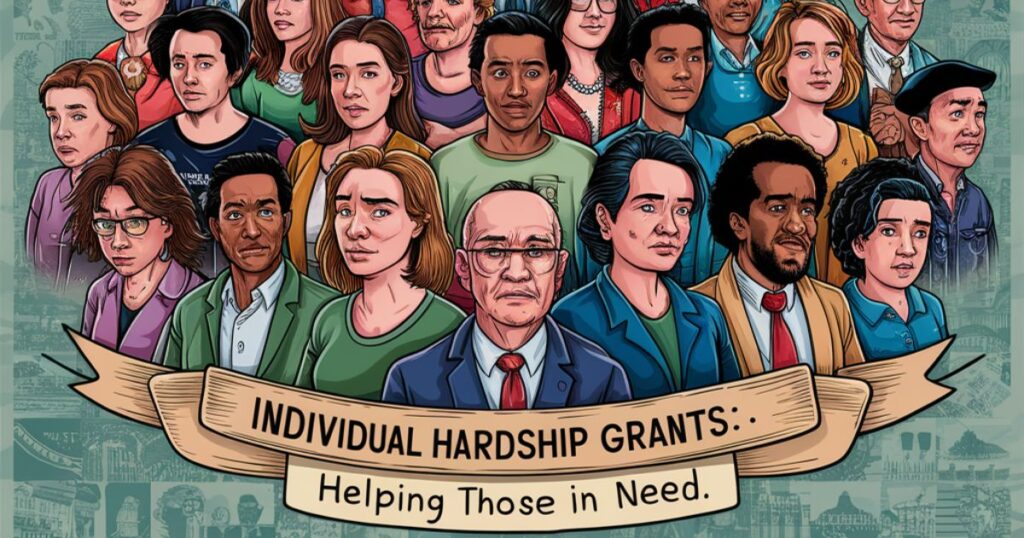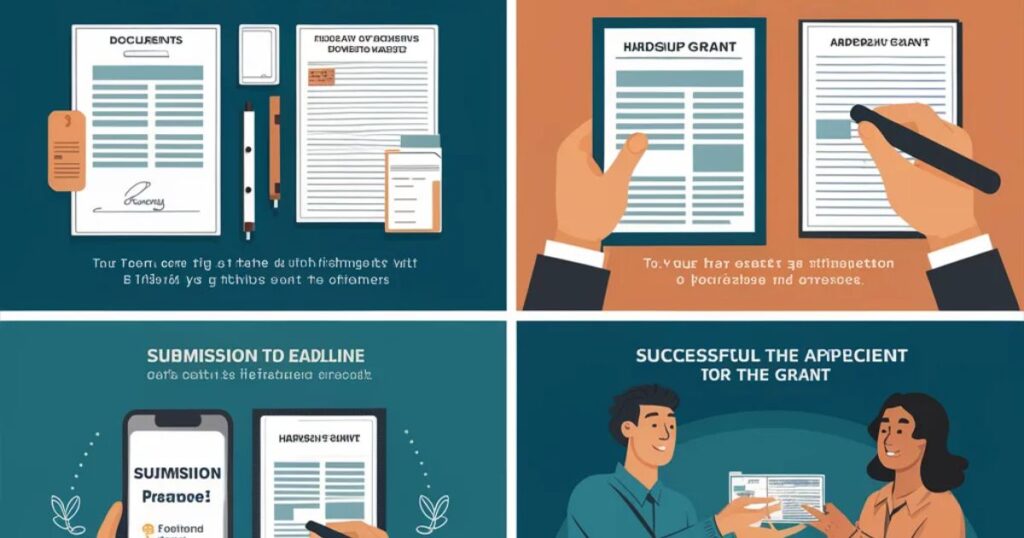Life can throw unexpected curveballs that derail even the most financially stable individuals. A job loss, medical emergency, or natural disaster can quickly spiral into a situation where you’re struggling to keep a roof over your head or food on the table.
When these hardships strike, it’s essential to know that there are resources available to help you get back on your feet. Hardship grants for individuals, offered by government agencies and non-profit organizations, can provide a much-needed lifeline during these challenging times.
In this comprehensive guide, we’ll dive deep into the world of hardship grants, exploring what they are, who qualifies, where to find them, and how to navigate the application process successfully.
Whether you’re facing a temporary setback or a more prolonged financial crisis, this guide will equip you with the knowledge and tools to access the assistance you need.
Table of Contents
What are Hardship Grants for Individuals?
Hardship grants are financial awards that do not require repayment, making them a valuable resource for those facing unexpected adversity.
Unlike loans, which can add to an already overwhelming debt burden, these grants are designed to provide immediate relief and support during times of financial hardship.
Hardship grants can assist with a wide range of needs, including:
- Emergency housing: Rent or mortgage assistance to prevent eviction or foreclosure.
- Medical bills: Help covering unexpected medical expenses or ongoing treatment costs.
- Food insecurity: Supplemental groceries or vouchers for food banks.
- Utility bills: Assistance with heating, cooling, and other essential utilities.
- Education and childcare: Grants to help offset childcare costs or educational expenses during hardship.
These grants are typically funded by government agencies, non-profit organizations, and private foundations, each with their own eligibility criteria and application processes.
Who Qualifies for Individual Hardship Grants in the USA?

Qualifying for hardship grants depends on several factors, and the specific requirements can vary depending on the program and organization offering the funds.
However, there are some common eligibility criteria that are often considered:
- Demonstrated financial hardship: This is the core requirement for most hardship grant programs. You’ll need to provide documentation proving a significant financial setback due to circumstances beyond your control, such as job loss, medical emergencies, natural disasters, or other unforeseen events.
- Income level: Hardship grants are typically targeted towards low-income individuals and families who lack the resources to cope with financial emergencies. Each program will have its own income threshold that you need to meet.
- Residency requirements: Many programs restrict eligibility to residents of a specific geographic area, such as a state, county, or city. This ensures that resources go to those the program was designed to help within the local community.
In addition to these primary factors, some programs may also consider:
- Number of dependents: Having dependents, such as children or elderly parents you support, might strengthen your application for certain grants.
- Existing debt levels: The amount of debt you currently have could be a factor, especially for grants focused on specific needs like medical bills or housing assistance.
- Employment status: While job loss is a common hardship, some grants might prioritize individuals who are actively seeking employment or participating in job training programs.
It’s crucial to review the specific eligibility criteria for each grant program you’re interested in to ensure you meet the necessary requirements.
Read this Post: PLESSNER COACHING IN LUTHERSTRASSE 2 34327 KÖRLE
Where to Find Legitimate Hardship Grant Programs
Finding legitimate hardship grant programs can be a daunting task, but there are several trusted resources available to help you navigate the process:
Government Websites
- Benefits.gov: This official U.S. government website (www.benefits.gov) is a one-stop shop for searching federal benefit programs, including hardship assistance. Use the search bar with keywords like “hardship grants” or your specific need (e.g., “rental assistance”).
- State and Local Government Websites: Each state and many local municipalities have their own websites with information on social services and financial assistance programs. Search for your state or local government’s official website, then navigate to sections on social services, financial assistance, or emergency preparedness.
Non-Profit Organization Databases
- National Foundation for Credit Counseling (NFCC): The NFCC (www.nfcc.org) offers a database of non-profit organizations that provide financial assistance, including hardship grants. Search by your zip code to find resources in your area.
- FindHelp.org: This website from ALICE (Asset Limited, Income Constrained, Employed) is a comprehensive resource for finding low-income assistance programs. Search by your zip code and filter by “financial assistance” to find hardship grant opportunities in your community (www.findhelp.org).
Grant Databases
- Grants.gov: This official U.S. government website (www.grants.gov) is a comprehensive database of federal grant opportunities. While most grants listed here are for organizations, some might be relevant for individual hardship assistance programs. Utilize keywords related to your situation (e.g., “medical hardship grant”) and filter by “Individual” under the “Applicant Type” category.
- GrantWatch: This website (www.grantwatch.com) is a private resource for searching grant opportunities from various foundations and organizations. It offers a free basic search and a paid subscription for more advanced search options. Utilize keywords related to your situation and location to find relevant programs.
When searching for hardship grant opportunities, it’s essential to be cautious of potential scams. Beware of unsolicited offers or requests for upfront fees, as legitimate grant programs do not charge application fees.
How to Apply for a Hardship Grant Successfully

Once you’ve identified a hardship grant program that seems like a good fit, it’s crucial to follow the application process carefully to increase your chances of success. Here are the typical steps involved:
- Gather Required Documentation: Most grant programs will require you to provide documentation to support your claims of financial hardship and eligibility. This may include:
- Proof of hardship (e.g., termination letter, medical bills, documentation of property damage)
- Income verification (e.g., pay stubs, tax returns)
- Residency proof (e.g., utility bills, lease agreements, driver’s license)
- Additional documents specific to the program’s requirements (e.g., childcare costs for childcare assistance grants)
- Complete the Application Form: Whether it’s a paper application or an online form, ensure you answer all questions truthfully and accurately. Clearly explain your financial hardship and how the grant will help you overcome this challenging situation.
- Submit Your Application by the Deadline: Pay close attention to the submission deadline and follow the instructions for submitting your application, whether it’s mailing it, uploading documents online, or attending an in-person drop-off session.
- Attend an Interview (if required): Some programs might require an interview to further assess your situation and need for assistance. Be prepared to answer questions about your financial hardship and how you plan to use the grant funds.
- Await Award Notification: The awarding process can take time, so be patient and keep an eye out for updates from the organization regarding the status of your application.
To increase your chances of success, consider applying to multiple grant programs that align with your needs. Additionally, stay organized by keeping copies of your applications, supporting documents, and any communication you receive from the programs.
If you encounter difficulties completing the application or have questions, don’t hesitate to contact the program directly. Many organizations have staff available to assist you with the application process.
Strengthening Your Hardship Grant Application
While meeting the eligibility criteria is essential, there are several strategies you can employ to strengthen your hardship grant application and stand out from the competition:
- Tailor Your Approach: Don’t submit generic applications. Research each program’s goals and tailor your application to highlight how their specific grant would address your unique situation.
- Demonstrate Financial Responsibility: Show the program that you’re taking steps to manage your finances responsibly during this hardship. Include details on any budgeting strategies you’ve implemented or efforts to find alternative income sources.
- Highlight Long-Term Goals: Explain how the grant will not only address your immediate needs but also help you achieve long-term financial stability. This could involve plans for job training, debt repayment strategies, or childcare solutions that will allow you to re-enter the workforce.
- Proofread and Edit: Ensure your application is free of errors and typos. A well-written and organized application makes a positive impression on the awarding body and demonstrates your attention to detail.
Remember, hardship grants are designed to provide temporary assistance during difficult times. By crafting a compelling and well-thought-out application, you increase your chances of securing the financial support you need to overcome your current challenges.
Additional Considerations
While the core steps of finding and applying for hardship grants are crucial, there are some additional considerations to keep in mind:
Deadlines and Competition:
Hardship grants often have strict deadlines, so it’s important to act swiftly when faced with financial difficulty. Additionally, be prepared for competition, as funding can be limited. Research past application periods to understand the level of competition for the programs you’re interested in.
Renewal Options:
Some hardship grants are one-time awards, while others offer the possibility of renewal, depending on your continued need and the program’s available resources. Understand the renewal process and requirements for any grants you receive.
Reporting Requirements:
For certain programs, you might be required to submit reports detailing how you used the grant funds to ensure they were used for their intended purpose.
Tax Implications:
Generally, hardship grants are not considered taxable income. However, it’s always best to consult a tax professional for specific guidance based on your individual circumstances.
Alternative Resources:
While hardship grants can provide invaluable assistance, it’s also important to explore other avenues for support, such as:
- Negotiating payment plans with creditors
- Seeking free or low-cost legal aid
- Utilizing food banks and community meal programs
- Accessing local housing assistance programs
Building a Stronger Application:
Here are some additional tips to strengthen your hardship grant application:
- Tailor Your Approach: Don’t submit generic applications. Research each program and tailor your application to highlight how their specific grant would address your unique situation.
- Demonstrate Responsibility: Show the program you’re taking steps to manage your finances responsibly during hardship. Include details on any budgeting strategies you’ve implemented or efforts to find alternative income sources.
- Highlight Long-Term Goals: Explain how the grant will not just address immediate needs but also help you achieve long-term financial stability. This could involve plans for job training, debt repayment strategies, or childcare solutions that will allow you to re-enter the workforce.
- Proofread and Edit: Ensure your application is free of errors and typos. A well-written and organized application makes a positive impression on the awarding body.
By taking these additional considerations into account, you can approach the hardship grant application process with greater confidence and increase your chances of securing the financial assistance you need.
Conclusion
Navigating financial hardship can be overwhelming, but hardship grants for individuals offer a beacon of hope and support. Whether you’re facing a temporary setback or a prolonged crisis, these grants can provide a lifeline to help you regain your footing and work towards long-term stability.
Remember, the path to securing hardship grants requires diligence, organization, and perseverance. Research thoroughly, gather the necessary documentation, and craft compelling applications that highlight your unique situation and long-term goals.
While the process may seem daunting, don’t lose hope. Numerous government agencies, non-profit organizations, and foundations are committed to assisting individuals in need. By taking advantage of these resources and seeking support when needed, you can navigate even the most challenging financial circumstances.
So, take a deep breath and embark on this journey with determination. A brighter tomorrow could be just one well-crafted application away.
